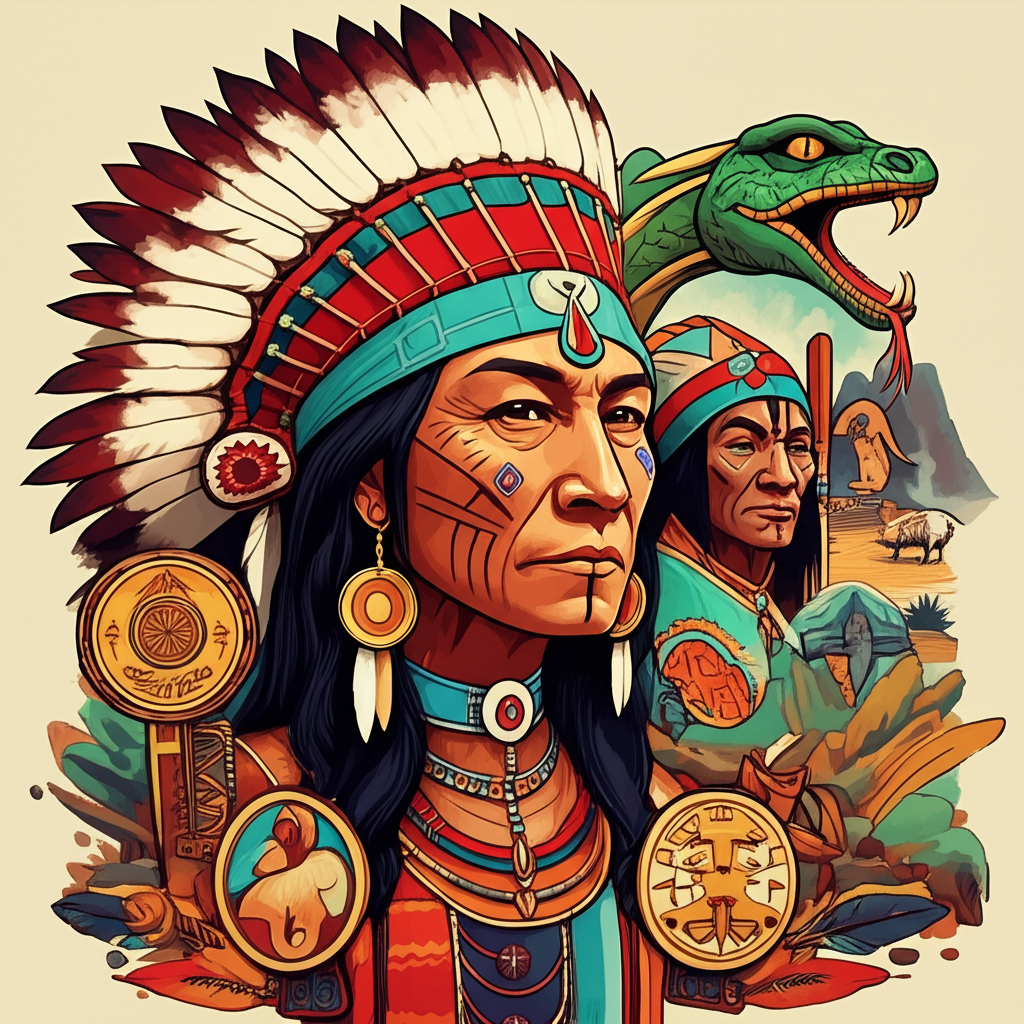
Introduction:
Across the vast landscapes of North America, many Indigenous cultures hold rich oral traditions passed down through generations. Among these are stories of powerful beings, symbols of creation, knowledge, and the delicate balance of the natural world. This article will explore the threads that connect the figure of White Buffalo Calf Woman from the Lakota Sioux tradition with the Horned Serpent found in various Indigenous mythologies, focusing on the Navajo Nation’s interpretation and understanding of these powerful symbols. It is crucial to remember that these are traditional stories, deeply embedded in the cultural fabric of these ancient peoples, and are presented here for cultural understanding and appreciation, not as factual or divine claims.
Origins and Cultural Background:
To understand these myths, we must journey back to a time when the world was intimately connected to the spirit realm. The Lakota Sioux, like many Plains tribes, lived a nomadic lifestyle, their lives interwoven with the cycles of the buffalo and the changing seasons. Their worldview was animistic, recognizing the spirit in all things – the animals, the plants, the rocks, and the sky. This spiritual connection was crucial for their survival, shaping their values, social structures, and relationship with the environment.
The Navajo Nation, residing in the arid Southwest, developed a complex social system based on kinship and clan affiliations. Their relationship with the land was equally profound, born of generations of adapting to and respecting the harsh environment. Their cosmology, expressed through intricate sand paintings and elaborate ceremonies, emphasized harmony, balance, and the interconnectedness of all things. Stories served as both entertainment and instruction, conveying moral lessons, historical events, and practical knowledge necessary for survival.
In both cultures, storytelling was not merely a form of entertainment; it was a vital means of preserving history, teaching values, and maintaining cultural identity. These stories were told and retold around campfires, in winter lodges, and during sacred ceremonies, passing down wisdom from one generation to the next.
Character / Creature Description:
White Buffalo Calf Woman is a central figure in Lakota Sioux cosmology. She is said to have appeared to two hunters during a time of hardship, bringing with her the Sacred Pipe, a symbol of unity, peace, and connection to the Great Spirit. She taught the people the sacred ceremonies, including the Sun Dance, and showed them how to live in harmony with the land. She is often depicted as a beautiful woman dressed in white buckskin, carrying the Sacred Pipe. Symbolically, she represents purity, renewal, spiritual guidance, and the return of prosperity after times of hardship.
The Horned Serpent, on the other hand, is a more widespread figure, appearing in various forms across many Indigenous cultures in North America. Often associated with water, lightning, and fertility, it is a powerful and complex symbol. The Navajo Nation recognizes a similar being, sometimes associated with water spirits or powerful forces of nature. It’s not always represented literally as a serpent with horns, but can also be linked to natural phenomena or powerful deities.
The Horned Serpent often represents the primal forces of nature, both destructive and life-giving. The horns can symbolize power, wisdom, and connection to the celestial realm. The serpent form represents transformation, healing, and the cyclical nature of life. In some traditions, it is seen as a guardian of sacred sites or a protector of water sources.
Main Story / Narrative Retelling:
Imagine, if you will, the rolling plains stretching as far as the eye can see, the air thick with the scent of buffalo grass and wood smoke. Two young Lakota hunters, weary and disheartened by a long, unsuccessful hunt, stumble upon a vision unlike any they have ever witnessed. A beautiful woman, radiating an ethereal glow, stands before them. She is dressed in white buckskin, and in her hands, she carries a sacred pipe adorned with eagle feathers.
This is White Buffalo Calf Woman. She tells the hunters that the people are suffering and that the Great Spirit has sent her to bring them a message of hope and renewal. She instructs them to gather the people and prepare for her arrival.
When she arrives at the village, she teaches them the sacred ceremonies, including the Sun Dance, a ritual of sacrifice and renewal that strengthens their connection to the Great Spirit. She shows them how to pray with the Sacred Pipe, how to honor the buffalo, and how to live in harmony with the land. Before departing, she promises to return when the people need her most, leaving behind a legacy of spiritual guidance and cultural renewal.
Now, shift your perspective to the arid canyons and mesas of the Navajo Nation. A young shepherd, tending his flock near a sacred spring, notices the water level receding. The land is parched, and the people are desperate for rain. He begins to pray, offering tobacco and cornmeal to the spirits of the water.
Suddenly, the ground begins to tremble. A powerful wind whips through the canyon, carrying with it the scent of rain. From the depths of the spring, a swirling vortex of water emerges, revealing a powerful being – not a literal serpent with horns, perhaps, but a manifestation of the water’s power, a force both terrifying and life-giving. This entity reminds the shepherd that the balance between humanity and nature must be maintained. Greed and disrespect will only lead to drought and suffering. The shepherd, humbled by the encounter, carries this message back to his people, urging them to respect the land and live in harmony with the natural world.
Symbolism and Meaning:
For the Lakota Sioux, White Buffalo Calf Woman represents the promise of renewal and the importance of spiritual connection. She embodies the values of compassion, generosity, and respect for the sacredness of life. Her appearance signifies a return to balance and harmony after periods of hardship.
Within the Navajo context, the water spirit or similar entity symbolizes the power of nature, both its ability to sustain life and its potential for destruction. It serves as a reminder of the importance of respecting the environment and living in harmony with the natural world. It highlights the consequences of disrespecting sacred resources and the need to maintain balance in all things.
Both figures, though distinct in their specific cultural contexts, share a common thread: they represent the power of the spiritual realm to influence the lives of humans and the importance of maintaining a respectful relationship with the natural world. They are reminders of the interconnectedness of all things and the need to live in harmony with the forces that shape our lives.
Modern Perspective:
Today, these myths continue to resonate in various forms of media and cultural studies. White Buffalo Calf Woman appears in literature, art, and film, often as a symbol of Indigenous resilience and spiritual strength. The Horned Serpent, or its variations, features in video games, fantasy novels, and academic discussions about Indigenous cosmologies.
These representations, while often well-intentioned, must be approached with sensitivity and respect for the cultural origins of these stories. It is crucial to avoid appropriation or misrepresentation and to ensure that these figures are portrayed in a way that honors their significance to the cultures from which they originate.
Conclusion:
The stories of White Buffalo Calf Woman and the Horned Serpent offer a glimpse into the rich cultural heritage of the Lakota Sioux and the Navajo Nation. They are powerful reminders of the importance of spirituality, respect for nature, and the interconnectedness of all things. These are cultural narratives passed down through generations, and it is important to appreciate them as such.
As Muslims, we believe that Allah is the one and only Creator and Sustainer of the universe. We can appreciate the cultural richness and imaginative power of these stories without ascribing any divine power to the beings they depict. These narratives offer valuable insights into the values, beliefs, and worldviews of different cultures, enriching our understanding of the human experience and the diverse ways in which people have sought to make sense of the world around them. Let us celebrate the beauty of storytelling and the enduring power of the human imagination while remaining steadfast in our faith.





